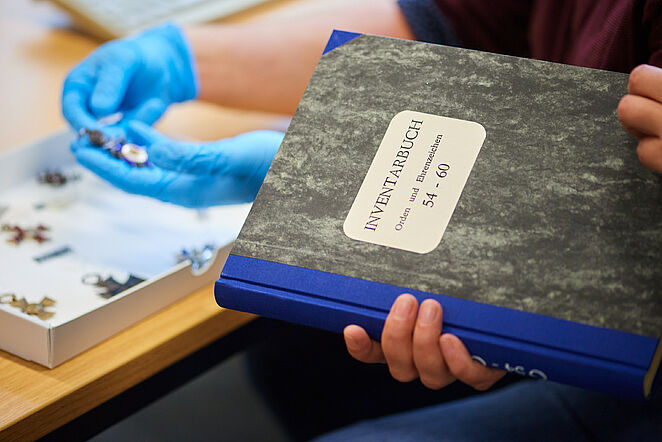Inventory research
The DHM systematically examines its collections for evidence of possible Nazi looting as well as expropriations in the SBZ/GDR. The characteristic provenance features of individual objects are vetted for such clues. If this approach yields potential findings, the individual objects are more thoroughly studied. Provenance research projects are structured according to the special features of our collections.

Characteristic of the DHM collections is their (cultural-)historical nature. Unlike collections focusing purely on art, our stocks are collected according to their historical significance and not primarily to art-historical criteria. This often results in complicated research methods. Many objects, for example, come from serial production, which makes it very difficult to identify individual objects that are suspected of looting. In addition, there are objects where the manufacturer or artist is not well-known and seldom mentioned in sources such as exhibition or auction catalogues.
Both the DHM and the MfDG were founded after the Second World War. The MfDG began to build up its collection in 1952, while the DHM started in 1987. For objects acquired after this time, it is very difficult to determine the previous owners and trading history from the time before 1945.
It can be assumed that only a fraction of the more than one million objects in the collections can be systematically examined for possible expropriation during the Nazi period, in the time of the Soviet occupation, or in the GDR. Therefore, the focus of provenance research in the DHM lies primarily with (nearly) unique objects, which can be found for the most part in our collections of an artistic nature, such as paintings and sculptures, drawings, graphic prints and applied art.
-
![]()
Publikation
Provenienzforschung in der Gemäldesammlung des DHM
Zwischen November 2017 und Oktober 2019 führte das Deutsche Historische Museum (DHM) ein vom Deutschen Zentrum Kulturgutverluste gefördertes Forschungsprojekt zur Überprüfung eines Teilbestandes der Gemäldesammlung auf mögliche NS-verfolgungsbedingte Entzugsvorgänge durch. Aufbauend auf dem bereits veröffentlichten Zwischenstand zum Projekt liegt nun der Abschlussbericht mit einer Zusammenfassung der Ergebnisse vor.
-
![]()
Publikation
Der „Hofzwerg“ aus der Sammlung des Theaterregisseurs Max Reinhardt
Seit 1988 befindet sich in der Gemäldesammlung des Deutschen Historischen Museums (DHM) das Porträt eines kleinwüchsigen Mannes in eleganter, höfischer Kleidung – eines „Hofzwergs“. Das DHM kaufte das Bild aus dem späten 17. Jahrhundert im Münchener Kunsthandel als Werk eines unbekannten Salzburger Meisters an. Bei der Rückseitenanalyse im Jahr 2018 konnten auf dem Keilrahmen zwei Aufkleber festgestellt werden, die das Bild mit dem Schloss Leopoldskron und der Sammlung Max Reinhardt in Verbindung bringen. Ein Blick auf die Rechnung aus dem Jahr 1988 bestätigte die Zuweisung an das Schlossinventar und die Sammlung Reinhardt.
Aufgrund dieser Hinweise wurde eine intensive Recherche durchgeführt, anhand derer die verschiedenen Facetten und Möglichkeiten der Provenienzforschung exemplarisch anschaulich werden. -
![]()
Publikation
Bruno Lohse und die Kaiserbilder Albrecht Dürers im Deutschen Historischen Museum
2003 erwarb das Deutsche Historische Museum zwei Albrecht Dürer und seiner Werkstatt zugeschriebene Porträts, Brustbilder von Kaiser Karl dem Großen und von Kaiser Sigismund. Als Verkäufer trat eine nicht näher bezeichnete Schweizer Familienstiftung auf. Die vom Museum vor dem Ankauf in die Wege geleitete Überprüfung der Herkunft der Bilder ergab keine Hinweise auf Raub- oder Fluchtgut.
Erst 2015 fanden sich Anhaltpunkte, dass die Bilder aus dem Besitz von Bruno Lohse stammten, der zwischen 1941 und 1944 für die nationalsozialistische Kunstrauborganisation Einsatzstab Reichsleiter Rosenberg in Frankreich tätig war. Eine Spurensuche begann. -
![]()
Publikation
Die verborgene Geschichte eines Gemäldes von Adolph Menzel
Bevor das Gemälde "Borussia" von Adolph Menzel 2001 an das Deutsche Historische Museum kam, erregte es großes öffentliches Interesse. Es war das erste Kunstwerk eines Berliner Museums, welches nach Verabschiedung der "Washingtoner Erklärung" von 1998 aus deutschem Bundesbesitz an die rechtmäßigen Erben im Jahre 2000 restituiert wurde.
Ausgehend von den zum Teil rätselhaft wirkenden Aufschriften und Etiketten der Gemälderückseite lässt sich an dem Kunstwerk exemplarisch eine nahezu vollständige Objektbiografie veranschaulichen.



